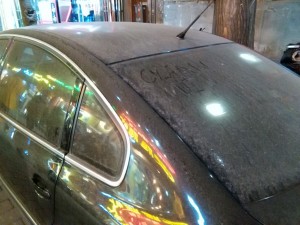February 4, 2015
Some people were asking about what it’s like to live in Beijing given their air’s reputation for being extremely polluted. The post below, I hope, gives you some idea.
When in China, do as the Chinese do. I’ve bought a mask in an attempt to stifle the amount of PM2.5 (smog) that I inhale when the “haze” descends upon Beijing. Here’s a photo.
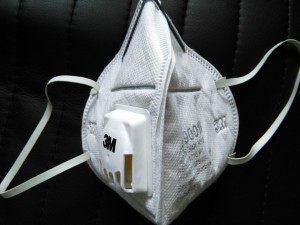
I’m not sure how much it helps. The mask doesn’t seal properly against my face and so I still feel the air around the sides of the mask. It does stop the smell of the smog, but I’m not sure how effective it is at cleaning the air I breathe.
So what is PM2.5? It’s only the most dangerous type of pollution there is. Okay, maybe it’s not as bad as uranium waste or other similar things, but it does kill slowly and, surprisingly, smells like a delightful bonfire. PM2.5 is the industrial emissions spewing from the tops of the smoke stacks outside of Beijing. Since November’s APEC meeting the Chinese government has said that it will step up measures to combat air pollution, specifically in Beijing but also in other cities. My trip to Xi’an was under the cover of a haze. Xi’an is a little different from Beijing because it still has city walls which act as a trap for the city’s smog. Further, the smoke stacks are closer to the city centre than they are in Beijing.
One of the worst and most apparent drawbacks of this smog is the look of Beijing: it looks positively run down. It’s just dirty. To be fair, on clear days Beijing can look beautiful, especially its parks. But buildings that have only recently been built look as if they’ve been standing there for decades after a year or so immersed in smog. All of them are covered in this grey grime that, although it washes off, is pointless to remove because as soon as another smog cloud rolls in, the building will be covered once again.
I asked one of my students what they do when the air is really bad. She responded, “I don’t go outside.” Fair enough. It reminds me of my answer to the question of how we Canadians (especially us prairie folk) live in such a cold country. More often than not I say, “We don’t go outside.” On another occasion, another girl, who was apparently tired of hearing about Beijing’s smog problem, said quite succinctly, “There’s more to China than it’s smog.” She is right. It’s just very hard to ignore the haze.
Finally, I should note that Beijing has one natural occurring phenomenon that helps with the smog: wind. Beijing’s wind helps move the smog cloud away and disperses it over a greater distance (which Korea often complains about, especially if the Gobi Desert sends its yellow sand across the continent.) It doesn’t eliminate the problem but it does clear the air for a few days.
All that noted, most expats will tell you two things: first, the problem has gotten worse in recent years and, second, this year really isn’t as bad as last year. So perhaps efforts to curb the city’s smog problem have helped.
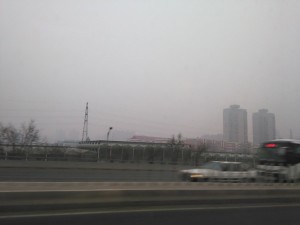
But how are they curbing that air pollution?
By shutting down factories and dividing up the driving days between odd and even license numbers. Mostly it’s either stopping production or moving production away from cities. And that brings me to my next point…
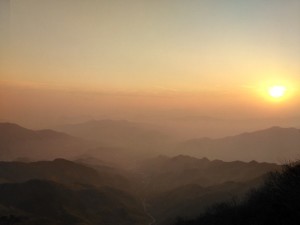
Unless you’ve been living under a rock, a lot of people talk about how the 21st century is going to belong to China (it should actually be Asia, not just China) and how China is the world’s biggest economy and blah blah blah. The number they look at is the GDP which, if you uncover those neurons that mildly recall that Grade 10 social studies class, is the Gross Domestic Product which measures how much a country produces each year. Well, China’s number has been declining, from 9.3% in 2011 to 7.7% in 2013 and currently sits around 7.4% (Source: CIA World Factbook). To most people this number won’t mean anything, to others it means that China’s economy is shrinking, fast. It may be that China is addressing its smog problem since their GDP numbers (and manufacturing output) is declining anyway. But to get back to the point, Beijing’s haze problem has become a major problem.
Part of the clean up may mean that we see fewer “Made in China” labels on your items. Instead, you’ll start seeing “Made in Bangladesh / India / Indonesia” and possibly even Africa where environmental laws aren’t so strict and, more importantly, is out of the public eye. Is this a bad thing? Well, from the looks of it we (and I include myself in this category) are not going to consume less, if anything, we’ll consume more but we don’t want to pay higher prices. But as a country develops, wages rise and that shrinks a company’s bottom line. Any sensible business owner would look for ways to increase his bottom line, and that may include moving production elsewhere.
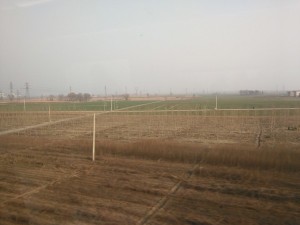
Anyway, China wants to curb its industrial emissions but it seems more like they want to move it away from the cities, not stop it at its source. However it happens, the dust continues to pile up in the cities. A thought struck me the other day as I walked past a line of cars: As snow is to Canada so dust is to China.
So what would I say to someone who wanted to move to Beijing or other parts of China? I’d still say come on over. This country is developing fast and there is no doubt in my mind that even ten years from now Beijing, and the rest of China, is going to look completely different.
Let’s just hope they/we can fix the smog problem so we can actually see the country.
